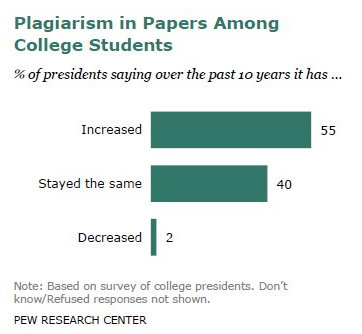Plagiarism is a growing social phenomenon that plagues universities and academic institutions worldwide. Plagiarism not only destroys the meaning and value of education, but it also contributes to the decay of the role of research in civil society. The development and deployment of Internet access to multiple information resources particularly accentuated the phenomenon and method. Pressured by strict deadlines and the pressure to succeed, students often resort to unethical means to complete their work. The purpose of this section is to explore the issue of plagiarism both from the learner and the teacher’s perspective. We conclude by presenting simple, yet practical suggestions on how educators can help students avoid committing plagiarism. We welcome your participation in this discussion and encourage you to send us your own ideas and tips.

According to a 1991 study conducted by Rutgers University, 66% of 16,000 students from 31 prestigious U.S. universities have cheated at least once. Among the 66% who admitted to cheating, 12% reported that they had plagiarized on multiple occasi0ns. (source: plagiarism.org)
A Pew Research Center survey reports that 55 percent of college presidents around the country believe plagiarism is on the rise.

This video highlights students’ understanding of the concept of plagiarism and what they believe could help address it. All the students who are interviewed in this piece seem to have a good grasp on what it means to plagiarize, but they also expressed the need for instructors to explicitly teach how to summarize, paraphrase and cite sources.
Students plagiarize for various reasons. While plagiarism is often associated with dishonesty and laziness, in many cases, the act of committing plagiarism is not intentional and is more related to the mechanics of integrating and citing sources. The following are some of the main factors behind plagiarism:
- Students with poor academic and research skills are most likely to plagiarize.
- Lack of understanding of the correct rules for citing and referencing outside sources.
- Students are often unaware of the concept of intellectual property and, therefore, do not see the necessity of attributing sources.
- Prioritizing higher grades over the pursuit of intellectual development.
- The pressure to turn-in assignments may lead a student to plagiarize in order to meet the submission deadline.
- Frequent interaction with a text may cause students to actually internalize the content and ideas, leading them to think that those ideas belong to them.
- Lack of interest in the content of the course may lead a student to plagiarize because he/she doesn’t believe that the course is useful and relevant.
- In many cultures, copying from others is considered a form of flattery.
Students are often judged as the sole responsible in cases of academic plagiarism. Professors and academic integrity committees tend to focus on the act of committing plagiarism, without looking at the bigger picture to try and assess the root causes that lead a student to plagiarize. Research has shown that there are simple steps that professors can take to educate their students about the meaning of plagiarism and guide them towards a better understanding of the processes of crediting outside sources. Here are a few examples:
- Ask a librarian Schedule a library orientation with your class early in the semester. An academic librarian will go over the entire process of doing research, including finding information, assessing the quality of resources and how to properly integrate and cite outside sources.
- Teach by example: Provide students with examples of essays, reports, or research papers and spend some class time going over the structure and the mechanics of both in-text citing and bibliography. This would serve as a reminder and a reference when your students are working on their own projects.
- Teach the rules: Teach your students the basics of academic writing. Paraphrasing, summarizing and citing are skills that most freshman students need to learn and practice in order for them to successfully apply them to their writing.
- Use the syllabus: Your syllabus should heave clear guidelines specifying the style format (MLA, APA, Chigago…etc). It is also important to include the school’s academic integrity policy along with explicit statements describing the serious consequences of plagiarism.
- Share resources: Use your course management system, class wiki or just your syllabus to share helpful tools that students can use to learn about the proper ways to paraphrase, summarize and cite sources. AP’s Student Resource Section is a wonderful free resource to recommend to your students.
- Be creative: Draft your assignment in ways that are unique, original and specifically targeted at the learning goals/objectives you have setup for your course. Avoid unfocused and generic topics that are easily available on on Internet essay banks and paper mills.
- Know your students: Assign informal in-class writing activities to measure the writing competencies of your students. Being familiar with the writing style of your student is good deterrent to discourage them from copying.
- Students’ ownership of the learning process: Create a healthy learning environment where students are able to see the meaning and value of what they are learning. Empowering students gives them a sense of pride and builds their motivation.
- Positive reinforcement: Acknowledge when a student does an excellent job citing and referencing outside sources. Use this student work as a model when teaching others students about what constitutes a well cited and correctly formatted paper.
- Rubrics and checklists: Rubrics are a simple, yet powerful tool for scoring students’ writing and giving feedback. Further, they provide clear guidelines for students to ensure they have met all the requirements for a given assignment. An assignment rubric is the perfect place to specify the guidelines for citing sources. Checklists are a great companion to every assignment. Including an entry for citations and bibliography would be a great reminder for students to have before they submit their work for assessment.
- Online tutorials and assessment: Academic institution may consider including an online plagiarism module as part of their freshman orientation process. All freshman students will be required to access the module on their school’s CMS, complete the interactive tutorial and pass the assessment quiz.

